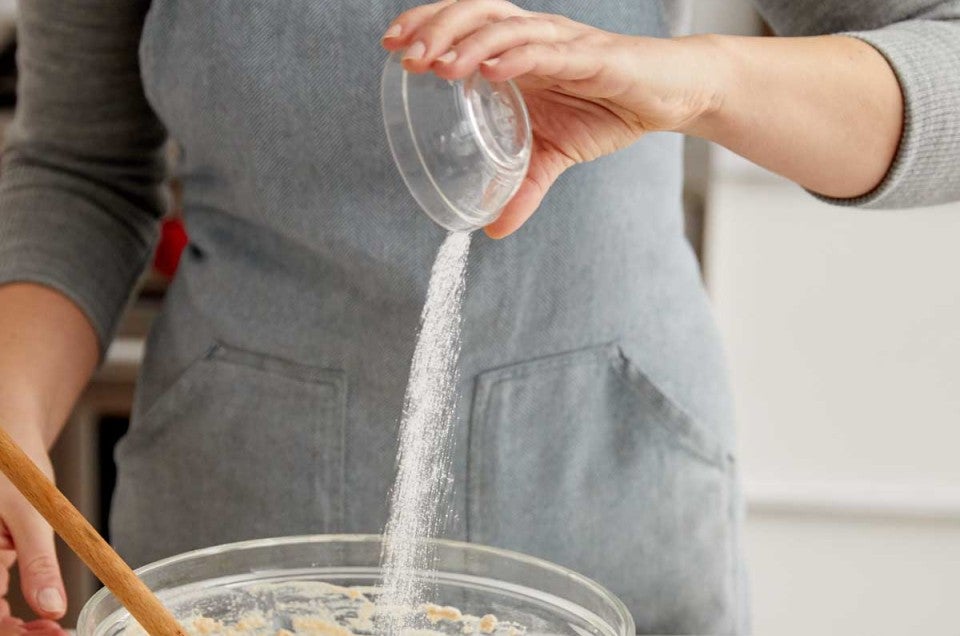What if I forgot to add salt to my bread dough?
Oh, and I left out the yeast too! Can my bread be saved?


 The bakers of King Arthur are here to solve the kitchen conundrums you share with us, whether it’s on the phone, computer, or by the good old postal service. In Ask the Baker’s Hotline, Annabelle will pick the brains of the talented King Arthur Baker’s Hotline team to tackle some of your most-asked questions.
The bakers of King Arthur are here to solve the kitchen conundrums you share with us, whether it’s on the phone, computer, or by the good old postal service. In Ask the Baker’s Hotline, Annabelle will pick the brains of the talented King Arthur Baker’s Hotline team to tackle some of your most-asked questions.
* * *
When you finish kneading a batch of bread dough, the last thing you want to see is the pre-measured salt you meant to put IN that dough still sitting on the counter. Since bakers commonly forget to add ingredients like salt and yeast to their bread dough, I asked Laurie Furch of our Baker’s Hotline how she’d remedy this potentially sticky (or very flat) situation. Being a bread pro, she sent me nearly 1,000 words of wisdom back! Here are her best tips.
I have good news: You can save your bread! You might be able to catch this one using visual and textural cues. Salt-less dough will be sticky and loose as you knead, as salt naturally absorbs moisture and tightens gluten strands. If you're thinking it would be easier to simply taste a piece of dough to check for saltiness, remember that flour is a raw ingredient and unbaked dough should never be consumed. Trust your eyes and fingers if things seems off.
“Because salt helps to control fermentation, it’s better to catch this one sooner than later in yeast doughs,” says Laurie. Without salt, your dough will rise faster than it normally would, leading to less flavor development and a weaker structure.
To incorporate the salt, mix it with a few teaspoons of water. Return your dough to the mixer, tear it into three to six pieces, and drizzle the liquid on top. Laurie directs: “Mix on low speed with a dough hook until it comes back together. It’s going to slop around a bit! That’s OK. Turn the mixer on and off a few times and rearrange the dough to be sure the liquid is mixed in.”
If you forgot the salt while kneading sourdough bread, don’t worry. Just pretend you meant to do it and call it an “autolyse,” a common technique used to develop structure when making artisan breads. After letting the dough rest anywhere from 20 to 60 minutes, mix in the salt and proceed with the recipe.
There’s not much you can do. Laurie explains, “Waiting until the dough is fully risen and then trying to add salt won’t work in your favor. Those beautiful air bubbles have spent all that time developing. If you re-knead the dough to add the salt, you risk doing irrevocable damage to the dough structure.”

Thankfully, you can bake it anyway. Bread without salt is still edible, it’s just rather bland and pale. Serve with spreads, herbs, or salted butter for a boost of flavor. Better yet, use the dough for pizza crust! Add assertive toppings like prosciutto, olives, or sun-dried tomatoes.
Whether you deduced this by spotting your yeast on the counter or realized your dough was missing its signature yeasty aroma, don’t fret! It won’t be perfect, but by no means is it a lost cause. You can add the yeast using the same technique used to add the salt.
Prefer to knead by hand? No problem! Laurie has you covered.
“To do it by hand, press the dough out flat as you can and spread the yeast [or salt] slurry over the surface,” she says. “Roll it up one way, then press it out, rotate it 90°, and roll again. Fair warning, it will be a bit messy. Re-knead it until it’s relatively smooth again.”

Adding yeast after the fact can mean it won’t be as evenly distributed, so yeast may concentrate in little pockets. A longer fermentation in the fridge can help to mitigate this.
Well, it probably isn't much of a rise without yeast! You can still attempt the same technique described above, but Laurie says that “you risk slightly over-kneading the dough and damaging the gluten strands, which can affect the rise and final texture of the dough.”
Expect a potentially denser, shorter loaf. That said, maybe this is an “ugly duckling” situation: You could press the dough into a 9” x 13” pan with some olive oil and call it focaccia — no one will know anything even went awry!
Got a question you'd like answered? Drop it in the comments below, and I’ll see you next month with more baking insights from the King Arthur Baker’s Hotline!
Cover photo by Kristin Teig.

